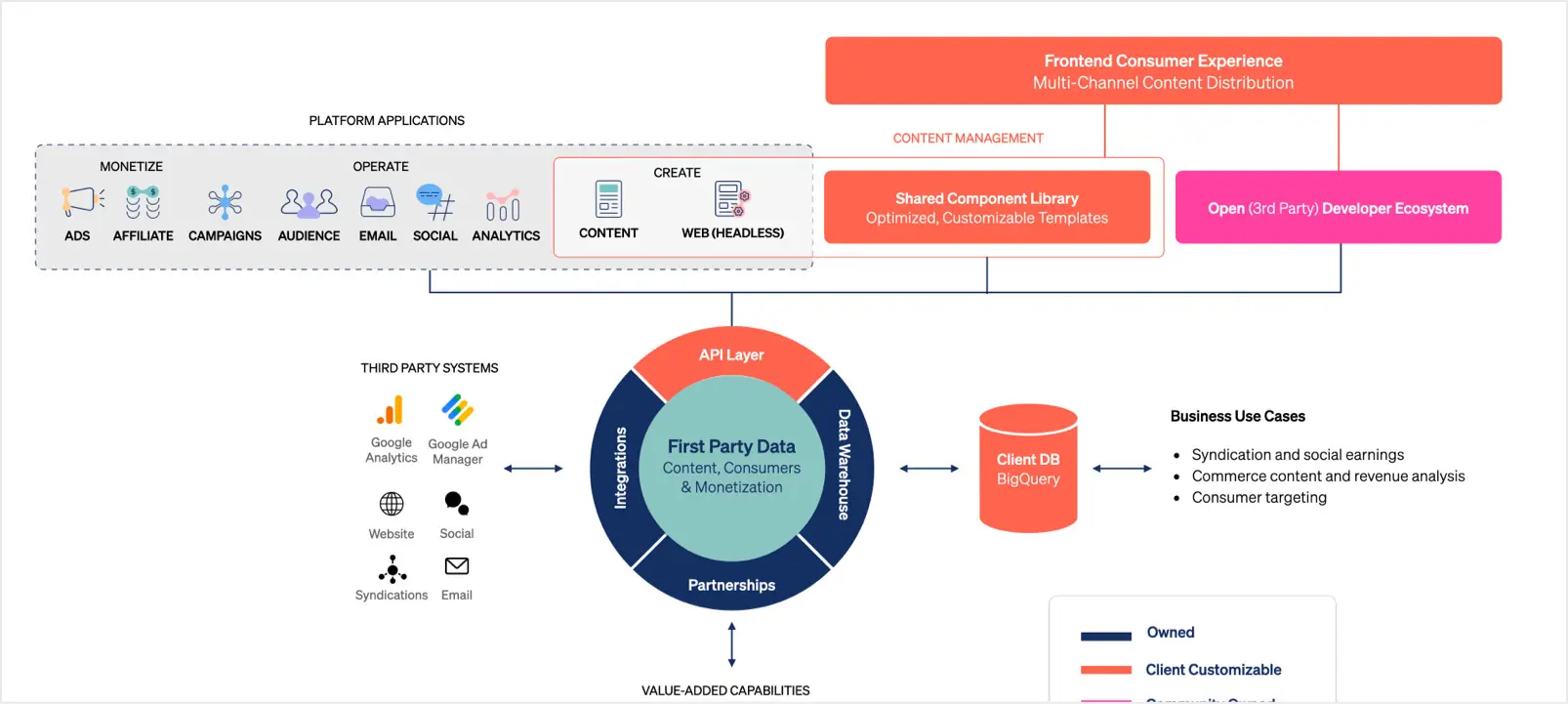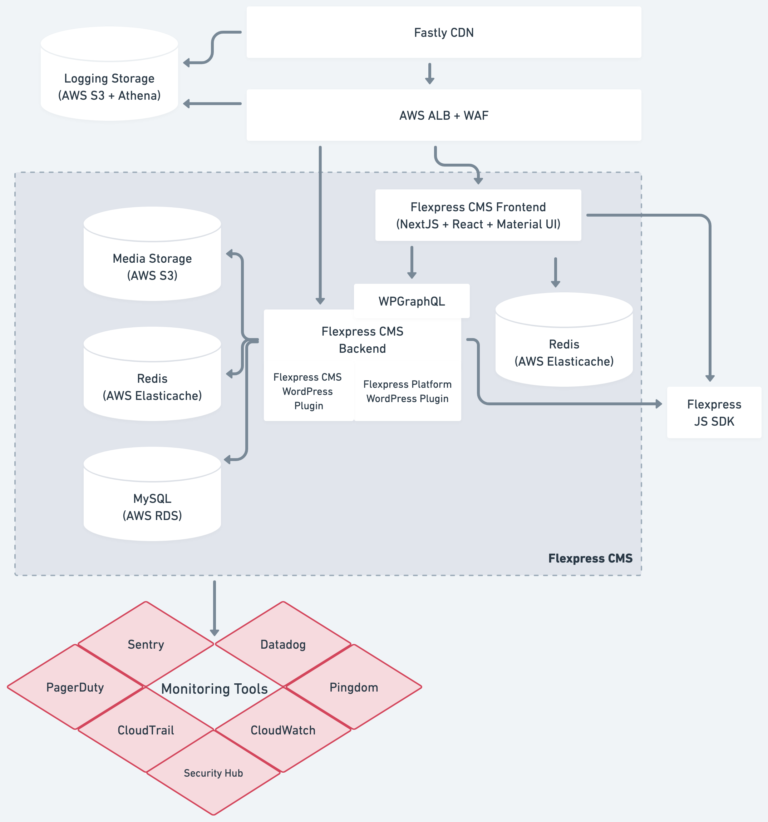[ In a nutshell ]
Flexpress Technology Stack
SaaS Platform: Flexpress is a SaaS platform integrating the various products needed to solve critical high-traffic website business KPIs: #1 site speed; #2 audience and revenue growth; #3: content and engineering ROI.
Decoupled CMS: Via GraphQL API, the Flexpress React/Next.js frontend remains decoupled (“headless”) from the WordPress backend. The main benefit for engineering teams being faster and easier development driven by: #1: Premium hosting and site monitoring; #2: Data migrator tool and frontend component library to instantly build sites; #3: Ultra-secure backend with WordPress-intuitive editorial interface; #4: Integrated and high-performance tools for monetization, and analytics.
First-Party Data: Everything in Flexpress drives toward publisher-owned, first-party data stored securely in our clients’ data warehouses to power blazing-fast speed, streamlined API integrations, and AI efficacy.
Flexpress = Open Source
Flexpress is a frontend React/Next.js project with a GraphQL API connecting to a Django (Postgres) backend deployed on AWS RDS.
We’ve integrated the following open source platforms to provide more value to our customers, who want to have faster, more secure sites that earn more monthly revenue: Google BigQuery: acts as the data warehouse; Docker and Kubernetes: (via AWS EKS) for containerization and orchestration; Celery: how we run asynchronous tasks; Sentry and Datadog: monitoring and security; Pytest, Jest, and Selenium: primary ways we write tests.
Specific developer features include:
- Premium hosting with seamless backend plugin management
- Frontend library for faster development with React and Next.js
- Backend monitoring and regulatory, including GDPR and CCPA
Technology stack: Architecture
Blazing-Fast, High-Earning Sites
Flexpress Overview for CTOs and Engineers
”We like working with Flexpress not only because of its great technology, but also because of its amazing team. This is one of the most client-oriented companies I know.
Denis StebunovFounder, Ivelum
”Flexpress allows us to skip a bunch of steps, and really, really focus on the user. The best part of working on SAVEUR with Flexpress was that we could just focus on the UI, and just focus on the interactions—the little animations here and there that usually get pushed out. With Flexpress, the project took weeks vs. months— we could just focus on the fun stuff.
Greg AllenCEO, First + Third
How Engineers Work with Flexpress
Flexpress’s architecture makes it easier and faster for engineers to build high-speed, high-earning websites—all while providing max stability and security for content, users, and owners.
- First-party data: Engineers working with Flexpress’ technology stack receive access to site-specific repositories in which they can create their preferred frontend and backend changes, including creating special blocks, widgets, and eye-catching designs. Engineers are free to release these new features in accordance with their team’s preferred schedule.
- Enterprise Github: Any domain fully-launched on Flexpress gets a site-specific Github repository for organizing backend and frontend development. In addition, Flexpress specializes in providing enterprise clients with additional backend functionality that provides edit ability across a portfolio of domains (commonly referred to as an “organization” repository).
- Flexible Development: Requests for changes to the core Flexpress codebase can be submitted at any time. We encourage engineers propose changes as soon as possible, so that we can work together to complete the work and drive optimal success.
Technology Stack: Operations
Premium DevOps and Site Monitoring
Flexpress monitors your sites 24/7/265 for maximum uptime, performance, and security
Maximum Stability
Flexpress uses AWS Cloudwatch Alarms to monitor critical AWS resources including RDS, Elasticache instances, and SES reputation. Flexpress tracks the all of the following metrics for you, so your team can focus on other priorities:
- RDS: CPU usage, IOPS burst balance, free storage space
- Elasticache: memory usage, current items number
- SES: Reputation, BounceRate, Reputation, ComplaintRate
If any metric registers outside of the preferred performance threshold, AWS immediately and automatically notifies Flexpress via Slack for investigation.
Availability 24/7/365
Flexpress sites have more than 99.99999% uptime. We use Pingdom to monitor uptime for all hosted sites, with particular focus on homepages, sitemap pages, and other critical content.
Pingdom sends health checks to Flexpress every minute. If no response is received, Pingdom sends a notification to PagerDuty.
PagerDuty notifies Flexpress engineers and product managers via Slack and Flexpress’s 24/7/365 on-call engineering team by phone to ensure prompt investigations.
A+ Application Performance
Flexpress uses Datadog for APM and infrastructure monitoring. The Datadog agent is installed on every EC2 host on staging, and on production EKS clusters. The Datadog agent collects the infrastructure data about CPU, memory, and free disk space, for every host. Flexpress monitors 24/7/365 all the following scenarios:
- High CPU usage
- Low free disk space
- Out-of-memory (OOM) event happened
- Impressions per ad unit anomaly detected
- Impressions per site anomaly detected
Flexpress installs Datadog packages at the code level to track application performance, including database queries, code-level call latency, requests to third-party services, dependencies, and other performance metrics.
Never Hacked, Never Down
Flexpress uses Sentry to track application errors for hosted sites. Sentry packages are installed on a code level and send error details to the Sentry dashboard. If any error fits the specified alert rules, FlexPress engineers and product managers are notified via Slack for immediate investigation.
Flexpress also maintains its own tools to monitor critical site functionality, including:
Robots.txt changes:
If changes are made to robots.txt files, PagerDuty alert generated.
Failed cron jobs:
Every five minutes, Flexpress tracks failed Kubernetes CronJobs in production and staging clusters.
WordPress Post modified date alerts:
If any WordPress post date was modified programmatically, alert sent immediately to Flexpress engineers via Slack.
Flexpress: Available Any Time to Solve Engineering Questions
Flexpress brings a radical support mindset to making sure websites reduce technology friction. We want site owners to focus on growing their business; with our team tackling backend engineering minutiae. For our customers we can:
- Design and implement custom-coded experiences
- Build AI-enabled content recirculation and site search
- Execute multi-site portfolio migrations to unified platform
”When I acquired SAVEUR in 2023, I chose Flexpress to power our CMS, ads, and commerce. Flexpress' technology stack and top-notch support program allow me to focus on the work I truly love: creating transportive food and travel content for our readers.
Kat CraddockCEO and Editor-in-Chief at Saveur
Flexpress FAQ
What are your server reliability and uptime scores?
Flexpress uses AWS and Fastly as Cloud Web hosting and CDN solutions, both of which promise at least 99.999% uptime scores. Flexpress-hosted sites perform at this rate, as measured by Pingdom.
What security features do you offer?
Flexpress provides security features such as Web Application Firewall, DDOS protection, and Vulnerabilities Scanning. For a full breakdown of Flexpress’s security features, please contact Customer Support at support@flexpressai.com.
How often does Flexpress face downtime?
Flexpress-hosted sites have more than 99.99999% uptime, with minutes of outages per year (if that) across hundreds of millions of monthly pageviews.
If the event of an outage, what is your average response time?
Flexpress’s internal alert system allows us to respond immediately in the event of an outage.
How many customers share a single server?
Flexpress uses AWS Elastic Kubernetes Service; customer applications (e.g. sites and related services) thus work in isolated Docker containers.
Is it possible to scale up or down once I'm on Flexpress servers?
Yes, it is possible to scale up or down resources based on client requests. When responding to requests to scale up or down, Flexpress may recommend optimizations that will more effectively address the underlying reason why such a request was made. The Flexpress DevOps team configures the infrastructure to optimize speed, performance, and cost; we hold deep value for site and application performance. Flexpress’s hosting solutions allow for almost infinite scalability in terms of CPU/RAM, traffic, and storage to be able to handle sites of limitless sizes.
Does Flexpress monitor hosted sites for downtime or other potential concerns?
Yes, Flexpress offers 24-hour monitoring, with an alerts ecosystem integrating Pingdom, PagerDuty, Sentry, DataDog, AWS Cloudwatch, and more.
How often do you back up websites?
We do a production database backup every night around 1 a.m. UTC, and all backups are stored in S3.
What do you use for a domain registrar?
Namecheap.
When was the announcement about Flexpress, and CEO Ajay Rayasam?
August 27th we officially launched publicly as Flexpress. Subsequent changes will roll out over time, with our goal being only to serve our customers better.
What is Organic.ly?
Founded as Organic.ly, our team launched publicly as Flexpress on August 27, 2024 because the name Flexpress best reflects our commitment to flexibility at scale, open-source innovation, and blazing-fast site speed that maximizes audience and revenue potential for customers.
- Website: Our website is flexpressai.com; that’s where you go if you enter Organic.ly into your browser. If it’s easier to remember going forward, you can also access our site using the URL flexpress.ai.
- Emails: You can contact Flexpress using @flexpressai.com email addresses. All emails sent to our @organic.ly addresses will still reach us via our flexpressai.com inbox.
- Support: to get support, you can always email support@organic.ly, but please try to use our the support email: support@flexpressai.com.

































